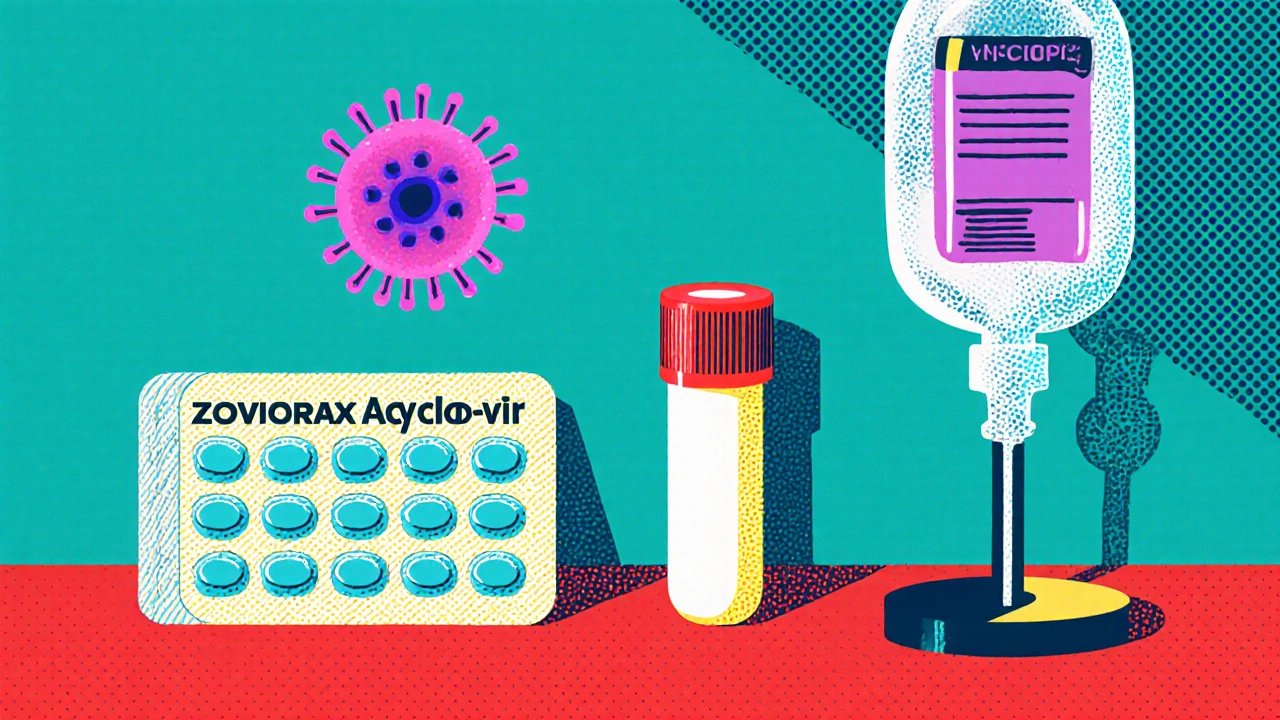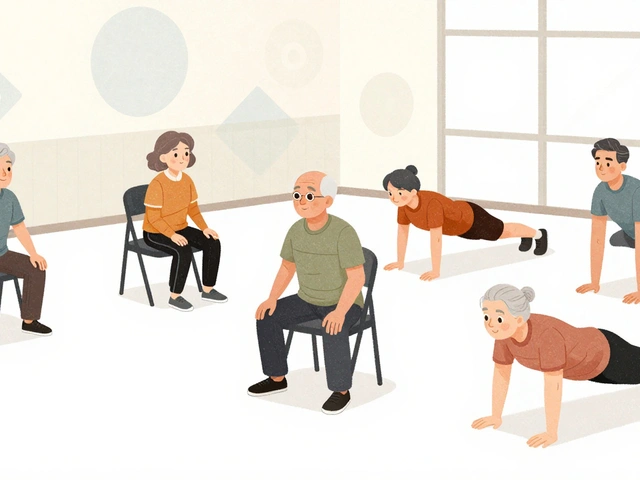Herpes Treatment Selector
Find Your Best Antiviral Option
Select your condition and priorities to see which alternative to Zovirax best matches your needs.
Your Recommended Option
Why This Works For You
Considerations
Zovirax (Acyclovir) is a prescription antiviral medication that targets DNA replication of herpes viruses. It comes in tablets, topical creams, and IV formulations, and is commonly used for outbreaks of genital herpes, cold sores, and shingles. While effective, many patients ask whether newer or over‑the‑counter options work better, cheaper, or cause fewer side effects. This guide breaks down the most popular alternatives, highlights where each shines, and helps you decide which choice matches your health needs.
Why people compare Zovirax with other antivirals
Doctors prescribe Zovirax because it’s been on the market for decades and has a solid safety record. However, three trends drive the comparison craze:
- Convenience: Some newer drugs require fewer daily doses.
- Cost: Generic versions of alternatives can be cheaper than the brand‑name pill.
- Side‑effect profile: Patients report nausea or headaches with Acyclovir, prompting a look at milder options.
Understanding how each alternative stacks up against the benchmark Zovirax vs alternatives lets you have a data‑driven conversation with your clinician.
Top oral and topical alternatives
The most frequently discussed substitutes fall into two categories: oral prodrugs that the body quickly converts to acyclovir, and topical agents that work directly on the skin.
Oral prodrugs
- Valacyclovir (brand Valtrex) - a valyl‑ester of acyclovir that offers higher bioavailability, meaning you take fewer pills.
- Famciclovir (brand Famvir) - a prodrug of penciclovir, approved for shingles and genital herpes.
Topical agents
- Penciclovir cream (Denavir) - applied five times a day, works directly on the lesion.
- Docosanol (Abreva) - an over‑the‑counter (OTC) lip‑balm‑like product that blocks viral entry.
Side‑effects and safety considerations
All antivirals share a core concern: they can affect healthy cells at high doses. Below is a quick snapshot of the most common adverse events reported in clinical practice.
- Zovirax (Acyclovir): nausea, headache, and rare kidney irritation when dehydrated.
- Valacyclovir: similar GI upset but typically milder; headache is less frequent.
- Famciclovir: occasional dizziness and fatigue; skin rash in < 2% of users.
- Penciclovir cream: mild local irritation, itching, or redness.
- Docosanol: virtually no systemic side‑effects; occasional skin dryness.
People with kidney disease should have dose adjustments for all oral agents, especially Zovirax, because it is cleared renally.
Dosage convenience - a practical comparison
Fewer pills mean better adherence, especially during a busy work week. Here’s how the regimens differ:
| Drug | Form | Typical Adult Dose | Daily Frequency | Prescription? |
|---|---|---|---|---|
| Zovirax (Acyclovir) | Tablet, Cream, IV | 400 mg | 5 times | Yes |
| Valacyclovir | Tablet | 1 g | 1‑3 times | Yes |
| Famciclovir | Tablet | 250 mg | 3 times | Yes |
| Penciclovir cream | Cream | Apply thin layer | 5 times | No (prescription for severe cases) |
| Docosanol | Topical ointment | Apply 5 g | 5 times (first 48 h) | No (OTC) |
When you factor in travel, work trips, or school schedules, the once‑daily dosing of valacyclovir often wins the convenience vote.
Cost landscape in 2025
Price is a major driver of choice. Below are typical out‑of‑pocket costs in Australia (2025 data) for a 30‑day supply, assuming standard insurance coverage.
- Zovirax (Acyclovir): AU$35-$45 for generic tablets; branded version can be over AU$120.
- Valacyclovir: AU$70-$90 for a 30‑day pack of 1 g tablets.
- Famciclovir: AU$55-$80 for 250 mg tablets.
- Penciclovir cream: AU$20-$30 for a 5 g tube.
- Docosanol (Abreva): AU$15-$25 for a 2 g tube (OTC).
Generic acyclovir remains the cheapest prescription pill, but if you need fewer doses, valacyclovir’s higher price may still be offset by better adherence and fewer missed doses.
Clinical effectiveness - does the alternative work better?
Multiple head‑to‑head trials have measured time to lesion healing, viral shedding duration, and recurrence rates.
- Cold sores: Valacyclovir reduces healing time by about 1‑2 days compared with acyclovir, thanks to higher blood levels.
- Genital herpes: In suppressive therapy, valacyclovir cuts breakthrough episodes by roughly 50% versus acyclovir.
- Shingles: Famciclovir shows a modest advantage in pain reduction during the first week, but the difference is clinically small.
- Topical agents: Penciclovir cream works similarly to oral acyclovir for cold sores but must be applied very frequently; Docosanol offers a 30% faster resolution if started within 48 h of symptom onset.
Bottom line: oral prodrugs (valacyclovir, famciclovir) generally outperform standard acyclovir in speed of recovery, while topical creams are useful for mild, localized outbreaks.
Resistance and special populations
Long‑term antiviral use can lead to viral mutations that render the drug less effective. Resistance rates differ:
- Acyclovir (Zovirax): < 1% in immunocompetent patients; higher (up to 10%) in transplant or HIV‑positive groups.
- Valacyclovir: Mirrors acyclovir because it converts into the same active molecule.
- Famciclovir: Slightly lower resistance in immunocompromised people, as penciclovir binds DNA differently.
If you have a compromised immune system, your doctor may prefer famciclovir or combine therapy with topical agents to reduce resistance pressure.
How to pick the right option for you
- Assess severity: Mild cold sores often respond to OTC docosanol; severe or recurrent episodes need prescription therapy.
- Consider dosing schedule: If you struggle with five‑times‑daily pills, switch to valacyclovir.
- Check kidney function: Reduced renal clearance warrants dose cuts for acyclovir and its prodrugs.
- Factor in cost: Generic acyclovir is cheapest, but insurance may cover valacyclovir better.
- Review side‑effect tolerance: If nausea is a deal‑breaker, try the topical penciclovir or docosanol.
Bring this checklist to your next appointment; a clear outline speeds up the shared‑decision process.
Frequently Asked Questions
Is Zovirax still the best choice for shingles?
For most patients, Zovirax works well, but valacyclovir or famciclovir can shorten pain duration by a day or two. If you need fewer pills, the newer drugs are often preferred.
Can I use over‑the‑counter docosanol instead of a prescription?
Docosanol is effective for early‑stage cold sores if you start within 48 hours. It won’t replace prescription therapy for genital herpes or severe outbreaks.
What’s the main difference between acyclovir and valacyclovir?
Valacyclovir is a prodrug that the body converts into acyclovir, giving higher blood levels and allowing once‑ or twice‑daily dosing. The antiviral effect is otherwise the same.
Are there any foods or drinks that interfere with these antivirals?
No major food interactions are documented, but staying well‑hydrated helps the kidneys clear the drug and reduces the risk of kidney irritation.
How long should I stay on suppressive therapy?
Guidelines suggest 6‑12 months for frequent outbreaks, but your doctor may adjust the duration based on response and side‑effects.
Bottom line
If you value convenience and are willing to pay a bit more, valacyclovir usually wins on dosing and speed of healing. For tight budgets, generic Zovirax remains a solid, evidence‑backed option. Topical penciclovir or docosanol are handy for mild, localized cold sores when you prefer a non‑systemic route. Talk to your healthcare provider with the points above, and you’ll land on the antiviral that fits your lifestyle, health profile, and wallet.





Tamara Schäfer
October 25, 2025 AT 14:25When you sit down to compare antivirals, you’re really stepping into a micro‑cosm of modern medicine, where efficacy, convenience, and economics intersect in a delicate dance. The history of acyclovir is a testament to how a single molecule can change the lives of millions, yet its five‑times‑daily regimen feels like a relic from a bygone era. Imagine a world where you only need to swallow a pill once a day and still outrun the virus-that’s the promise that valacyclovir brings, and it’s not just marketing hype. The pharmacokinetics tell a story of higher bioavailability, meaning you get more drug in the bloodstream with less effort, which translates to better adherence for busy people. On the other hand, the prodrug famciclovir may not be as widely known, but its active form, penciclovir, hangs around cells longer, giving a gentle yet persistent antiviral pressure.
From a cost perspective, the generic acyclovir remains the underdog champion; it’s cheap, effective, and rarely causes serious side effects. Yet the hidden cost of missed doses can erode its advantage, especially when patients experience nausea and simply stop taking it. That’s where the beauty of a once‑daily regimen shines, reducing the cognitive load and the temptation to skip. The side‑effect profile of valacyclovir is impressively mild, with headache frequencies dipping below those seen with acyclovir, making it a kinder choice for those prone to migraines.
Resistance is another axis that warrants our attention. While acyclovir resistance is still under 1 % in immunocompetent hosts, the numbers climb in transplant patients, reminding us that we must tailor therapy to individual immune status. The cross‑resistance between acyclovir and its prodrugs means that simply switching from Zoviriv to Valtrex isn’t always a loophole, but famciclovir’s distinct binding can sometimes circumvent this hurdle.
Finally, think about the lived experience: a teenager juggling school, a professional with travel, or an elderly patient with renal concerns. The dosing convenience, the pill burden, and the cost line up differently for each. In many cases, the modest price premium you pay for valacyclovir pays off in time saved and symptoms shortened. So, when you’re faced with the decision, weigh the numbers, the biology, and the human side-because after all, medicine is as much about the person as it is about the pathogen.
Shannon Stoneburgh
October 28, 2025 AT 12:25The cost difference alone can make a big impact on choice.
Nathan Comstock
October 31, 2025 AT 10:25Look, folks, the American healthcare system may be flawed, but at least we've got the best antivirals on the market, and anyone who doubts the superiority of valacyclovir over the old‑school Zovirax clearly hasn't read the clinical data. The once‑daily dosing is not just convenient-it's a statement of progress, a testament that we can outpace the virus with fewer pills, and that's a win for any patriot who values efficiency. And let's be real, the side‑effects of acyclovir are a relic of a slower era; nausea and headaches are just the price you pay for sticking with outdated regimens. If you want the fastest healing and the most reliable suppression, the numbers don't lie: valacyclovir cuts breakthrough episodes in half compared to Zovirax. So, when you hear someone championing the old drug out of nostalgia, call them out-they're living in the past.
Terell Moore
November 3, 2025 AT 08:25Oh, brilliant, another self‑appointed authority spouting statistics like they're party tricks. It's adorable how you reduce complex pharmacology to a patriotic soundbite, as if brand loyalty were a substitute for rigorous evidence. While you claim valacyclovir's superiority, you conveniently ignore the fact that generic acyclovir remains far more cost‑effective for the average consumer, especially when insurance coverage is spotty. Dismissing centuries of clinical experience with a wave of nationalist flair does little more than expose your shallow understanding of therapeutic nuance.
Amber Lintner
November 6, 2025 AT 06:25Honestly, it's refreshing to see someone finally tear down the glorified myth of "newer is always better." The reality is that many patients, especially those on a tight budget, will happily stick with Zovirax if it gets the job done, and they don't need a drama‑filled lecture about "progress." Besides, the idea that a single pill can magically solve everything is pure hype; real healing comes from consistent adherence, not from the hype‑filled marketing of "once‑daily miracles."
Lennox Anoff
November 9, 2025 AT 04:25One must consider the ethical dimensions of prescribing practices, particularly when a cheap, efficacious drug like generic acyclovir exists alongside more expensive prodrugs. The temptation to default to the newer, costlier options can be seen as a subtle form of pharmaceutical paternalism, where the prescriber assumes superiority without fully accounting for the patient's socioeconomic reality. Furthermore, the healthcare system bears a responsibility to allocate resources wisely; enabling patients to access affordable therapy reduces the overall financial strain on society. In light of these considerations, it is incumbent upon clinicians to engage patients in transparent discussions, weighing both clinical benefits and economic implications.
Olivia Harrison
November 12, 2025 AT 02:25Absolutely, and to add to that, sharing a simple checklist-like the one outlined in the original post-can empower patients to make informed choices without feeling overwhelmed. It’s also helpful to remind them to stay hydrated, especially with acyclovir, to protect kidney function. If cost is a major concern, checking pharmacy discount cards or bulk generic options can further lower out‑of‑pocket expenses. Happy to chime in with any other practical tips!
Bianca Larasati
November 15, 2025 AT 00:25Let me tell you, I was battling a stubborn cold sore outbreak last month, and I tried everything-from home remedies to that pricey valacyclovir. After reading this guide, I finally switched to the over‑the‑counter docosanol, applied it religiously within the first 48 hours, and guess what? The sore faded dramatically faster than I expected! It was like watching a fireworks show in slow motion-so satisfying to see the virus quit the stage early. If you’re hesitant about OTC options, give them a shot; they might surprise you.
Corrine Johnson
November 17, 2025 AT 22:25Wow, what an inspiring account, Bianca!, you really captured the essence of timely intervention, and, honestly, many people underestimate how critical those first 48 hours can be, especially when dealing with fast‑acting viruses,; your experience reinforces the data presented earlier, that early application of docosanol, can accelerate healing,; plus, the dramatic description adds a vivid, relatable touch, that many readers will appreciate,; keep sharing these personal victories, they truly make the science come alive!
Sarah Keller
November 20, 2025 AT 20:25Everyone, listen up-if you’re still debating whether to stick with Zovirax or upgrade to a newer antiviral, the answer is simple: prioritize your lifestyle and health goals, not the hype. For those who can afford the extra cost, valacyclovir’s convenience is a game‑changer; for budget‑conscious patients, generic acyclovir still delivers solid results. The key is to have a candid conversation with your provider, laying out your concerns, and together you’ll land on the regimen that fits your unique situation. No need to feel pressured by marketing-your well‑being comes first.
Veronica Appleton
November 23, 2025 AT 18:25Great points Sarah, I agree that talking with your doctor is essential and cost matters too
Zaria Williams
November 26, 2025 AT 16:25i totally get the struggle with taking pills 5 times a day its a pain but i found the cheap generic acyclovir works fine for me and i dont mind the side effects lol
Charlie Stillwell
November 29, 2025 AT 14:25Yo, the ROI on generic acyclovir is off the charts 💰-you get decent viral suppression with minimal overhead. The pharmacodynamic profile may not be as "flashy" as valacyclovir, but for most immunocompetent hosts it's more than sufficient. Plus, the pill burden trade‑off is a classic cost‑benefit analysis that many clinicians overlook. 🤓
Ken Dany Poquiz Bocanegra
December 2, 2025 AT 12:25Bottom line: match the antiviral to your clinical needs, budget, and dosing preferences for optimal outcomes.